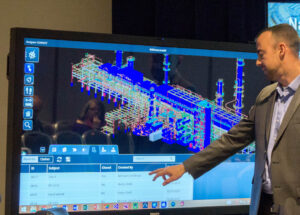Visualization is a hot topic as new means of interacting with data arrive. The Surface Hub is destined to change the meeting room forever.
Last June, Microsoft began talking about its long-awaited Surface Hub, a large screen touch device for conference rooms, in practical terms, i.e. price and shipping date. The 84-inch version of the screen was put at $20,000 and the smaller, 55-inch was priced at $7,000 and Microsoft has predicted shipments for early 2016. In reality, Microsoft customers have been able to buy the very big, very all-in-ones since July, 2015. Microsoft has built a worldwide channel for the device and a network of VARs.

Of course there was predictable outraged chatter around the price, but it’s not that out of line compared to projector-based conference room systems. There is a lot of interest in the Hub as a large-screen device as a window for remote conferencing as well as a platform for interactive discussions. In short, the Surface Hub touch screen sure beats a paper flip pad, a projector, and a phone hub. It also has the potential to replace expensive power walls in some companies.
Specs
Last summer, Microsoft also released the specs for the new Hubs, which are actually PCs with a special multi-touch screen. The screens have a refresh rate of 120Hz; the 55-inch has a resolution of 1920×1080 and the 84-inch is 3840×2160. The Surface Hub is based on Intel Haswell processors (i4 for the 55-inch and i5 for the 84-inch) with integrated graphics, but the 84-inch machine has an Nvidia Quadro K2200 for professional graphics capabilities. The Displays feature a projective capacitance optically bonded sensor supporting 100 multi-touch points, 3 simultaneously active pens. In addition, the displays come with ambient light sensors, 2 front facing speakers, 2 1080p cameras, and a high performance microphone.
Software is key
Microsoft is encouraging development for the panel and has a few showcase apps on its site. There are brainstorming tools, visualization, and diagramming tools. In addition, all applications written for Microsoft’s Universal App program will work on the Surface Hub screen, but the availability of useful tools for the Hub are key to the device’s ultimate acceptance. It must be easy for anyone to walk up to the screen, access information and maneuver. That’s a tall order.
The Microsoft Surface Hub has been long in coming. Introduced by Perceptive Pixel (PPI, founded in 2005), the multi-touch Surface Hub was the dreamchild of Perceptive Pixel’s Jeff Han, a charismatic presenter who could make his version of the Surface Hub sing with ideas, connections, and insights. Perceptive Pixel sold their displays primarily to TV companies where PPI-trained presenters could deliver weather reports, and political trends. The challenge for Microsoft has been to make the thing work for anyone as an off-the-shelf tool.
Two resources from the CAD companies will be included in Microsoft’s tool chest of apps for the Surface Hub. Bentley has announced its Navigator app, which is a visualization tool that allows teams to come together to see and navigate all the parts of a project together in context. The viewer is free to download but people have to have a Bentley Passport license in order to use it. Likewise, Siemens’ JT2go 3D viewer will be available for the Surface Hub touch screen. The JT standard is an open standard viewer and so JT2go is also free. No doubt there are more to come when the product goes into general availability in 2016. Microsoft has an active developer outreach program and SDK for the Surface Hub.
This is just the tip of the iceberg; 2016 is going to be an important year for visualization. We just returned from the SuperComputer conference in Austin where visualization was one of the major themes of the event. So, yeah, visualization in design software seems kind of obvious, but the challenge for the future is to manage and make meaningful the huge amounts of data that are being generated by software tools for design and analysis, visualization and rendering, and planning, not to mention data being thrown off by yappy things, buildings, factories, and machines.
Microsoft has an enviable position in the market right now. It has a cloud infrastructure, operating systems, a range of devices including the routinely born-again Surface PCs, game consoles, phones, the Hub, and the coming Hololens. There are also legions of machines with allegiance to Microsoft through their operating systems. Now let’s see what the software companies come up with.
Note: This story was corrected from an earlier posted version which misquoted the price for the 84-inch large-screen display at $10,000. The price is $19,999 and we made a pretty spectacular rounding error.





